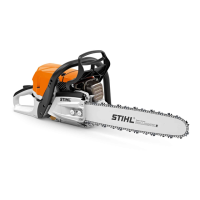► If the wood is sound and long-fibered:
Observe the following points when making
sapwood cuts:
–
The cuts must be the same at both sides.
–
The cuts must be at same height as bottom
of felling notch.
–
The width of the cuts is 1/10 of the trunk
diameter.
The trunk does not splinter when the tree falls.
11.8.5 Plunge cutting
Plunge cutting is a technique required for felling.
► Begin cut with the lower portion of the guide
bar nose – with chain running at full speed.
► Cut until depth of kerf is twice the width of the
guide bar.
► Swing the saw into plunge-cutting position.
► Perform the plunge cut
11.8.6 Selecting the Appropriate Felling Cut
The choice of appropriate felling cut depends on
the following conditions:
–
The natural inclination of the tree
–
The tree’s branch formation
–
Damage to the tree
–
The tree’s state of health
–
If there is snow on the tree: the snow load
–
The direction of slope
–
Wind direction and speed
–
Nearby trees, if any
There are different features of these conditions.
Only two features are described in this Instruc‐
tion Manual.
1 Normal tree
A normal tree is vertical and has an even
crown.
2 Leaner
A leaner stands at an angle and the crown
faces in the direction of fall.
11.8.7 Felling normal, small diameter tree
A normal tree is felled with a felling cut and stabi‐
lizing strap. This felling cut must be performed if
the tree diameter is less than the guide bar’s
length.
► Shout a warning.
► Plunge the guide bar into the felling cut until it
is visible at the other side of the trunk,
11.8.5.
► Apply the spiked bumper behind the hinge and
use it as a pivot.
► Enlarge felling cut in direction of hinge.
► Enlarge felling cut in direction of stabilizing
strap.
► Insert a felling wedge. The felling wedge must
match the tree diameter and the width of the
felling cut.
► Shout a warning.
11 Operating the Saw English
0458-788-0121-B 21

